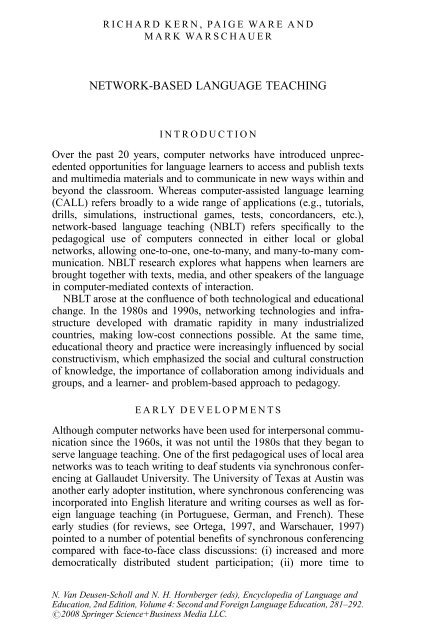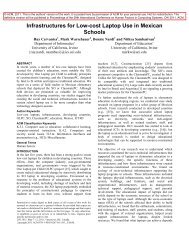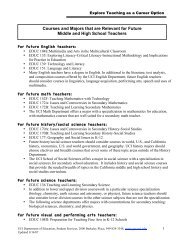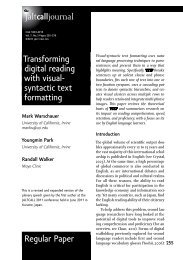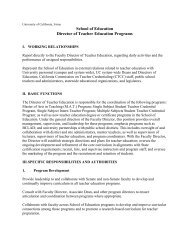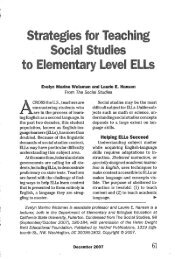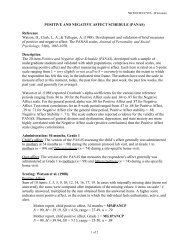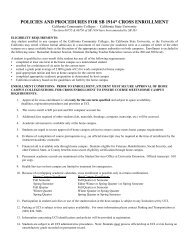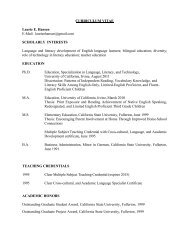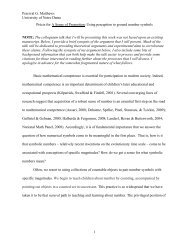NETWORK-BASED LANGUAGE TEACHING
NETWORK-BASED LANGUAGE TEACHING
NETWORK-BASED LANGUAGE TEACHING
You also want an ePaper? Increase the reach of your titles
YUMPU automatically turns print PDFs into web optimized ePapers that Google loves.
RICHARD KERN, PAIGE WARE ANDMARK WARSCHAUER<strong>NETWORK</strong>-<strong>BASED</strong> <strong>LANGUAGE</strong> <strong>TEACHING</strong>INTRODUCTIONOver the past 20 years, computer networks have introduced unprecedentedopportunities for language learners to access and publish textsand multimedia materials and to communicate in new ways within andbeyond the classroom. Whereas computer-assisted language learning(CALL) refers broadly to a wide range of applications (e.g., tutorials,drills, simulations, instructional games, tests, concordancers, etc.),network-based language teaching (NBLT) refers specifically to thepedagogical use of computers connected in either local or globalnetworks, allowing one-to-one, one-to-many, and many-to-many communication.NBLT research explores what happens when learners arebrought together with texts, media, and other speakers of the languagein computer-mediated contexts of interaction.NBLT arose at the confluence of both technological and educationalchange. In the 1980s and 1990s, networking technologies and infrastructuredeveloped with dramatic rapidity in many industrializedcountries, making low-cost connections possible. At the same time,educational theory and practice were increasingly influenced by socialconstructivism, which emphasized the social and cultural constructionof knowledge, the importance of collaboration among individuals andgroups, and a learner- and problem-based approach to pedagogy.EARLY DEVELOPMENTSAlthough computer networks have been used for interpersonal communicationsince the 1960s, it was not until the 1980s that they began toserve language teaching. One of the first pedagogical uses of local areanetworks was to teach writing to deaf students via synchronous conferencingat Gallaudet University. The University of Texas at Austin wasanother early adopter institution, where synchronous conferencing wasincorporated into English literature and writing courses as well as foreignlanguage teaching (in Portuguese, German, and French). Theseearly studies (for reviews, see Ortega, 1997, and Warschauer, 1997)pointed to a number of potential benefits of synchronous conferencingcompared with face-to-face class discussions: (i) increased and moredemocratically distributed student participation; (ii) more time toN. Van Deusen-Scholl and N. H. Hornberger (eds), Encyclopedia of Language andEducation, 2nd Edition, Volume 4: Second and Foreign Language Education, 281–292.#2008 Springer Science+Business Media LLC.
282 R. KERN, P. WARE AND M. WARSCHAUERdevelop and refine comments—possibly leading to greater precisionand sophistication of expression; (iii) encouragement of a collaborativespirit among students; (iv) enhanced motivation for language practiceand, in particular, greater involvement of students who rarely participatedin oral discussions; (v) reduction of anxiety related to oral communicationin a foreign language; and (vi) positive effects onstudents’ writing ability and perhaps speaking ability as well.There soon followed a number of studies that systematically comparedthe dynamics of synchronous conferencing with face-to-faceclassroom interaction (reviewed in Ortega, 1997, and Warschauer,1997). These studies confirmed the expected benefits of synchronousconferencing, with the exception of its effects on general writing andspeaking abilities—an area that has been taken up more recently (seeMajor Contributions later). They also revealed an overall greater levelof sophistication of students’ language use (in terms of the range ofmorphosyntactic features and discourse functions). However, synchronousconferencing was also found to introduce a number of unsettlingchanges. For example, Kern (1995) noted that teacher control overclass discussions was compromised, that the rapid pace of written discussionsometimes taxed students’ comprehension abilities, and thatalthough participation was more equitably distributed than in normalclassroom discussion, the coherence and continuity of discussionsoften suffered. Kern concluded that effectiveness had to be evaluatedin relation to instructional goals. Synchronous conferencing fosteredfree expression, student responsiveness, and the voicing of multipleperspectives on issues, but it did not improve grammar or reinforcestandard discourse norms.Noticeable in early NBLT studies was a tendency to test the technologyto see what effects it might have on language use. In the nextsection, we see a gradual shift toward testing theories of second languageacquisition (SLA) within the context of computer-mediatedcommunication.MAJOR CONTRIBUTIONSTwo general trends characterize the bulk of current research on NBLT.The first emphasizes SLA theory and interactionist models of learning.Data analysis typically consists of quantitative counts of the occurrenceof morphological, lexical, and syntactical features in online discourse.The second trend, described by Kern and Warschauer (2000) in theintroduction to their key collection of research articles on NBLT, isinformed by sociocultural and sociocognitive theories and draws on amixture of quantitative, qualitative, ethnographic, and discourse analyticmethods. At issue here is not only quantifying language development,
<strong>NETWORK</strong>-<strong>BASED</strong> <strong>LANGUAGE</strong> <strong>TEACHING</strong> 283but also understanding how learners interpret and construct meaningonline across culturally situated contexts.Although the primary research emphasis of each trend differs,the studies typically share a focus on discourse written by postsecondaryforeign language learners in asynchronous and synchronousenvironments.SLA-Grounded ResearchMost studies grounded in SLA theories of networked classroominstruction are either (i) comparison studies that examine the effectivenessof online vs. face-to-face interaction in promoting negotiation ofmeaning, noticing, comprehensible output, and form-focused learning(for a review see Kern, Ware, and Warschauer, 2004), or (ii) transferstudies that explore the degree to which language use online transfersto language proficiency more generally, particularly to speaking andlistening.Promoting negotiation of meaning. A major benefit for SLA-basedresearch is the ease of collecting interactional data online. In contrastto face-to-face conversation, online negotiation of meaning takes placein writing, which provides a readily usable database of transcripts forclassroom and research use. In classrooms, this database of interactionshas been used to facilitate the development of students’ metacognitiveand metalinguistic awareness (Sengupta, 2001). A significant numberof studies have examined task type in promoting negotiation of meaningin the network-based classroom. In a synchronous chat study ofintermediate level Spanish learners in a university course, Pellettieri(2000) found abundant evidence of form-focused modifications andcorrective feedback among ten dyads of English-speaking adult participants,leading her to conclude that online chatting can improve learners’grammatical competence (cf. Kern, 1995). Additionally, shefound that closed, goal-oriented tasks promoted greater frequency ofmeaning negotiation than open-ended tasks. A recent study by Smith(2003) supports Pellettieri’s finding, except that he found that decisiontasks promoted more negotiation of meaning than jigsaw tasks.Transfer studies. Implicit in this line of research is the expectationthat the linguistic and metalinguistic awareness developed online willtransfer to other domains of language learning. Students who can conversein spontaneous online chat discussions, for example, should havean easier time contributing to the ongoing flow of a face-to-face conversation.Not surprisingly, a wave of research has put this hypothesisto the test, with differing methods and outcomes. For example, usingrigorous quasi-experimental methods to examine the question of transferinto oral proficiency, Payne and Whitney (2002) provide strong
284 R. KERN, P. WARE AND M. WARSCHAUERevidence that the intermediate-level Spanish learners in the synchronouschat group outperformed the face-to-face control group on a pretest/posttestoral proficiency measure. In another quasi-experimentalstudy, Abrams (2003) considers language in a third-semester Germancourse. Although the students in the synchronous group producedhigher quantities of output in subsequent face-to-face discussions thantheir counterparts in either the asynchronous or control groups, shefound no statistically significant differences in terms of lexical richnessand diversity or syntactic complexity.To summarize, much of the research grounded in SLA theory and incross-modality transfer builds off the premise that language itselfremains a relatively stable target, and the overarching goals, outcomes,and processes of language learning are generally considered similarwhether conducted in physical or virtual space. Research is aimed atdetermining whether and to what extent technology-mediated interactioncan support language acquisition at least as well as face-to-faceinteraction.Sociocognitive and Sociocultural ApproachesResearchers who question the assumed stability and neutrality oflinguistic forms and functions in virtual discourse have turned theirfocus to two main areas: genre differentiation and culture learning innetworked classrooms.Genre differentiation. Online communication is not a single uniformgenre, but rather a range of genres generated situationally for differentmedia (e.g., blogs, e-mail, instant messaging, wikis, online forums,MOOs, chat groups) and according to the particular needs and purposesof participants. For example, synchronous online language is typicallycharacterized by the fragmentary nature of conversation flow, themultiplicity of discussion threads, the difficulty of back channeling toclarify one’s message, the lack of paralinguistic and contextual cues,and the tendency to emphasize phatic communication. Asynchronousmodes such as threaded discussion, however, tend to be less fragmentary,more informationally dense and complete, and focused on a singlediscussion topic. Variability in both technology and purpose leads to arange of online language that can resemble hybrid forms of standardand nonstandard language. Herring (2001) maintains that the fragmented,nonstandard language found in some online interactions isnot the result of errors, but rather the result of deliberate choices by usersto save typing time or to be creative with language. Warner’s (2004)work on language play corroborates this view by showing how learnersof German created hybrid language forms with code-mixing in their
<strong>NETWORK</strong>-<strong>BASED</strong> <strong>LANGUAGE</strong> <strong>TEACHING</strong> 285synchronous chat sessions. From a critical pedagogical perspective,however, such tendencies in online discourse create tensions for teachersintent on assisting their students in developing, if not proficiencyin standard forms of language, at least the ability to discern amongstandard, nonstandard, and hybrid uses.Culture in NBLT. A significant shift in NBLT in the last 5 years is thegrowing emphasis on cultural aspects of language learning. In part, theresult of theoretical trends toward sociocultural and social constructivistframeworks, and in part an outgrowth of the increasing popularity ofonline collaborative partnerships, many researchers are turning toa broader conception of language learning that insists on its inextricablecultural layering. Often referred to as telecollaboration, these internationalpartnerships link language learners in online discussions topromote language use and intercultural learning. Within the key pedagogicaland discourse analytical work on culture and NBLT (for anextended analysis see Kern, Ware, and Warschauer, 2004), the mostsignificant trends have been the move from monolithic to multidimensionalpresentations of culture (Furstenberg, Levet, English, and Maillet,2001); the notion of authenticity in online cultural texts (Kramsch,A’Ness, and Lam, 2000); the potential for communication breakdown(Ware, 2005); and the development of intercultural competence (Belz,2003).WORK IN PROGRESSNew studies investigating the viability of technology-integrated teachingfor supporting SLA and intercultural learning continue to appeareach month at a rate that shows little sign of slowing. The goals,content, and structure of NBLT are changing rapidly. Traditional definitionsof language learning, as measured by demonstrated proficiencyand control of the target language, no longer suffice as the primaryknowledge base for teachers in online contexts (see discussion in Wareand Kramsch, 2005). In contrast to the primarily task- and productoriented,classroom-controlled online interactions that characterizedearly research in NBLT, recent work examines online learning in twonew areas: nonclassroom contexts and multimodality.Nonclassroom ContextsEthnographic work has provided a unique lens on the kinds of languagepractices that shape linguistic socialization outside of the traditionalclassroom. Lam’s (2000, 2004) extensive research on Chinese-American adolescents documents how students develop textual
286 R. KERN, P. WARE AND M. WARSCHAUERidentities and hybrid language forms through their participation in multilingualonline communities. Such studies of how learners’ identitiesmediate (and are mediated by) their language practices outside educationalcontexts offer an important perspective for classroom teachers.In Thorne’s (2003) study of the “cultures of use” of online learning,for example, he notes the generational shift in college-level students’preference for conversing via instant messaging outside of class andtheir professors’ requirement that they communicate over e-mail forin-class work, resulting in a potentially derailing mismatch of tools andpurposes. Research by Black (2005) documents the experiences of adolescentEnglish language learners on fan fiction writing sites, and theways learners on these sites construct their identities as writers solicitand make use of peer feedback. By exploring the affiliations, preferences,and practices of learners in their chosen environments, researcherscan provide powerful insights into how we might change the shape ofclassroom-based teaching.Unlike the nonclassroom communities Lam documented, whichtypically form around common interests without an explicit focus onlanguage, tandem partnerships form online for the explicit purpose ofimproving proficiency in standard forms of the target language. Thesebilingual partnerships, grounded in two basic principles of learnerautonomy and reciprocity, are goal-directed toward improving traditionalmarkers of language proficiency such as syntactic complexity,lexical precision, and morphosyntactic accuracy. Two recent studieshave integrated the tandem model of learner autonomy and reciprocity,mostly used in voluntary contexts, into classroom-based MOO environments(Kötter, 2003; Schwienhorst, 2002). Although the focusof both studies was primarily on the development of linguistic andmetalinguistic awareness, Schwienhorst also found that studentsbecame more autonomous in their regulation of native and nonnativediscourse in their chatting.MultimodalityThe environments of technology-mediated teaching and learning arechanging to keep apace with innovations in technology tools. A majorshift in recent years has been toward the expansion of semiotic modesbeyond text. Increasingly, researchers are exploring the flexibility andinteractivity of multimodal venues for communication. Thorne andPayne (2005) provide a detailed inventory of cutting-edge research incommunication media such as blogs, wikis, podcasting, personal digitalassistants, and cell phones. They emphasize the importance ofthese personalized, portable multimedia tools, not merely for fosteringlearners’ linguistic proficiency in a conventional sense, but also for
<strong>NETWORK</strong>-<strong>BASED</strong> <strong>LANGUAGE</strong> <strong>TEACHING</strong> 287challenging them to use the technologies as a springboard for thinkingdeeply and engaging with content in the ways promoted in classroomlanguage instruction.Multimodal learning also includes bimodal chat rooms (Blake, 2005)and multimedia authoring tools (Nelson, 2006). Blake (2005) examinesa bimodal (oral and written) chat room, in which learners studyingSpanish as part of a distance learning course can write and speak toone another and their professor. Although he reports on a case studyof only a single learner, his analysis indicates that such bimodalCMC classrooms offer important new venues for student participationand negotiation of meaning. Nelson takes a different approach to multimodalityin his examination of postsecondary ESL writing studentswho, in addition to writing traditional print-based essays, authoredmultimodal projects. His analysis shifts the focus away from usual concernsof fluency and accuracy in foreign languages and suggests thatinstructors attend more broadly to students’ developing awareness oflanguage as just one aspect of a larger system of semiotics.PROBLEMS AND DIFFICULTIESAs NBLT expands its early focus on linguistic features to include cultural,communicative, and social aspects of online teaching and learning,a number of problematic areas arise. Differences in medium(Thorne, 2003), linguistic style (Belz, 2003), and levels of engagement(Ware, 2005) complicate online language learning.In order to grapple with these issues, researchers have adopted a numberof theoretical perspectives. Reeder, Macfadyen, Roche, and Chase(2004), for example, take an intercultural perspective on online communicationand suggest that significant cultural gaps and differencesin cyberculture values strongly impact the success or failure of onlinecommunication. Ess (2005) takes a postcolonial position and arguesthat because current CMC technologies favor Westernized values andcommunicative preferences, researchers need to work toward “middlegrounds” (p. 162) that better connect global trends with local traditions.Warschauer (2003), drawing on his ethnographic case studies of postsecondarywriting instruction (Warschauer, 1999), has pushed for a moreintegrated, nuanced conception of electronic literacy. He elaborates theplural construct of electronic literacies, including computer literacy,information literacy, multimedia literacy, and computer-mediated literacy,to investigate the relationship between the sociocultural contextsof networked classrooms and the particular ways that literacy is valuedand practiced by teachers, learners, and members of the larger society.Another issue has to do with technocentrism, which can draw ustoward testing the technology to the point where we risk becoming
288 R. KERN, P. WARE AND M. WARSCHAUERstagnated in terms of developing better theories of online language use.Related to technocentrism is the concern that technology-mediated languagelearning is becoming more and more commercialized, that is,packaged into convenient software programs and marketed to massaudiences. If the technology is attractive, it will tend to woo customers,regardless of the quality of its content or empirical base. In this regard,educators need to become critical consumers, just as their students needto evaluate online sources critically.Finally, a number of methodological and ethical issues arise as well.Due to the short-term duration of most NBLT studies, a great deal morelongitudinal research is needed to examine the effects of NBLT acrosstime. Tracking language learning through year-long or multiyear studieshelps mitigate, for example, concerns about how the novelty oftechnology might affect learner outcomes. Furthermore, longitudinalstudies provide a more adequate basis for understanding how languagelearning might transfer across skill areas, as researchers are betterpoised to track students across multiple contexts of use.Ethically, a key methodological issue has to do with subjects’informed consent to participate in research (and the real difficulty ofmaintaining student privacy in the virtual world.) It is easy to collectdata on the Internet without subjects’ knowledge or consent, andbecause boundaries between what is private and public are oftenunclear, it is essential that researchers follow procedures for obtaininginformed consent of subjects. Other ethical issues involve copyright/intellectual property issues, which are especially thorny in multimodalityprojects in which students download images, sounds, text, andvideo off the Internet. This is of course also tied to issues of plagiarismthat tend to coincide with the easy access of technology-mediatedlearning.FUTURE DIRECTIONSAs the field of NBLT develops in the coming years, research is neededthat continues many of the strands discussed earlier. In addition, weanticipate that research will grow in a number of other areas.First, more work is needed that explores multimodal learning contexts.Computers have had an impact on the ways we communicate.To date, the research conducted on computer-mediated communicationhas been mostly text-based, but now image and voice are becomingintegral parts of how we interact and represent ourselves online.As digital media become more readily available to wide audiences ofusers, teachers and students are increasingly able to develop novelways of integrating multiple modes of learning into the languageclassroom. In some cases, such integration will certainly take the form
<strong>NETWORK</strong>-<strong>BASED</strong> <strong>LANGUAGE</strong> <strong>TEACHING</strong> 289of more conventional approaches, such as the use of audio or videoclips to reinforce standard uses of the target language, but we alsoanticipate innovation in NBLT driven by newer technologies such aspodcasting and wikis, as documented by Thorne and Payne (2005).A second area of future research will likely be directed toward criticalexplorations of how culture functions in NBLT. Until now, termssuch as cross-cultural and intercultural have been used rather interchangeably,and the task of researchers will be to refine the terms anddevelop viable methodologies and theories for examining issues of(pluri)cultural representation, identification, and contact in online contexts.Work in this area will not only influence how we define languagelearning in general, but also how we define key concepts such as communicativecompetence, and how we frame online pragmatics andsociolinguistics.Third, expanded research will be needed on the relationship betweenform-focused in-class activities and online collaborations whose primarygoals are social interaction and the representation of identityand knowledge. Crucial to this research will be attention to changesin the roles of teachers and students and how the classroom is imaginedaccordingly.Fourth, as ethnographic work on language use and learning outsideof educational contexts continues to grow, we anticipate that researcherswill turn to the issue of curricular integration. As discussed earlier,much of the work on NBLT has taken place in postsecondary contexts.However, K-12 educators are increasingly interested in integratingtechnology into language classrooms, so researchers will need toexplore ways to support such curricular initiatives. With an emphasisin many K-12 educational contexts on high-stakes testing, such workwill undoubtedly facilitate the development of assessment tools andfeedback loops for learners and teachers.Finally, as more learning resources of all kinds become available viathe Internet rather than as stand-alone applications, the distinctionsbetween CALL and NBLTwill increasingly fade. New forms of researchwill be required to investigate the learning processes and outcomes thatoccur when traditional CALL activities are carried out in networkedenvironments and combined with computer-mediated communication.CONCLUSIONOver the past 20 years, a rich body of research has been conductedon NBLT. The accelerating diffusion of digital media and wirelessnetworks, together with the increased naturalization of computermediatedcommunication, promises that NBLT will remain a criticalarea for teaching and research. We note, for example, that the first
290 R. KERN, P. WARE AND M. WARSCHAUERgeneration of digital natives who have grown up using the Internet andview it as an entirely ordinary environment of interaction is now enteringhigher education. What’s more, the Internet itself has changeddramatically in recent years, with the rapid spread of participatory toolsand sites facilitating social networking, interactive game playing,collaborative writing and editing, and multimodal production. Thesetools provide opportunities for students in read, write, communicate,and construct knowledge in a second or foreign language in ways thatare both new and unexplored.Although the potential role of NBLT is thus greater than ever before,research has also shown that sound pedagogy and not computers or networksper se is what really counts in NBLT. Future success will thusrequire teachers’ continued attention to the close integration of projectgoals, activity/task design, and technology interface within oftencomplex logistical realities. Teachers also need to know how NBLTcan constrain as well as enhance their students’ language use andknow when it is better not to computerize a particular activity. Thegrowing complexity of decisions involved in NBLT highlights the importanceof technology integration in both preservice and inserviceteacher education.Finally, given the rapid evolution of technologies and the fluidity ofcommunicative environments, flexibility will be a prime requirementfor teachers and researchers as they continue to explore language teachingand learning in new networked contexts. By adopting the samehabits of mind that we seek to inspire in our students—autonomouslearning; inventive thinking; and critical perspectives on the intersectionof language, technology, and culture—teachers and researcherscan help ensure that the impressive potential of network-based teachingto transform language learning is achieved.See Also: Kevin Leander and Cynthia Lewis: Literacy and InternetTechnologies (Volume 2); Steven Thorne: Computer-mediated Communication(Volume 4); Robert Blake: Distance Learning for Second andForeign Language Teaching (Volume 4); Ilana Snyder: Research Approachesto the Study of Literacy, Technology and Learning (Volume 10);Joan Kelly Hall: Language Education and Culture (Volume 1); DavidBlock: Language Education and Globalization (Volume 1); MaryKalantzis and Bill Cope: Language Education and Multiliteracies(Volume 1); Alan Rogers: Informal Learning and Literacy (Volume 2);Brian Street: New Literacies, New Times: Developments In LiteracyStudies (Volume 2); Kathy Schultz and Glynda Hull: Literacies in andOut of School in the United States (Volume 2); Carey Jewitt: MultimodalDiscourses across the Curriculum (Volume 3)
<strong>NETWORK</strong>-<strong>BASED</strong> <strong>LANGUAGE</strong> <strong>TEACHING</strong> 291REFERENCESAbrams, Z.I.: 2003, ‘The effect of synchronous and asynchronous CMC on oralperformance in German’, Modern Language Journal 87(2), 157–167.Belz, J.A.: 2003, ‘Linguistic perspectives on the development of intercultural competencein telecollaboration’, Language Learning and Technology 7(2), 68–99.Black, R.W.: 2005, ‘Access and affiliation: The literacy and composition practices ofEnglish language learners in an online fanfiction community’, Journal of Adolescentand Adult Literacy 49(2), 118–128.Blake, R.: 2005, ‘Bimodal CMC: The glue of language learning at a distance’,CALICO Journal 22(3), 497–511.Ess, C.: 2005, ‘Moral imperatives for life in an intercultural global village’, inR.J. Cavalier (ed.), The Impact of the Internet on our Moral Lives, State Universityof New York Press, Albany, NY, 161–193.Furstenberg, G., Levet, S., English, K., and Maillet, K.: 2001, ‘Giving a virtual voiceto the silent language of culture: The CULTURA project’, Language Learning andTechnology 5(1), 55–102.Herring, S.C.: 2001, ‘Computer-mediated discourse’, in D. Schiffrin, D. Tannen, andH.E. Hamilton (eds.), The Handbook of Discourse Analysis, Blackwell, Malden,MA, 612–634.Kern, R., Ware, P.D., and Warschauer, M.: 2004, ‘Crossing frontiers: New directionsin online pedagogy and research’, Annual Review of Applied Linguistics 24,243–260.Kern, R. and Warschauer, M.: 2000, ‘Theory and practice of network-based languageteaching’, in M. Warschauer and R. Kern (eds.), Network-Based Language Teaching:Concepts and Practice, Cambridge University Press, Cambridge, UK, 1–19.Kern, R.G.: 1995, Restructuring classroom interaction with networked computers:Effects on quantity and quality of language production, Modern Language Journal79(4), 457–476.Kramsch, C., A’Ness, F., and Lam, W.S.E.: 2000, ‘Authenticity and authorship in thecomputer-mediated acquisition of L2 literacy’, Language Learning and Technology4(2), 78–104.Kötter, M.: 2003, ‘Negotiation of meaning and codeswitching in online tandems’,Language Learning and Technology 7(2), 145–172.Lam, W.S.E.: 2000, ‘L2 literacy and the design of the self: A case study of a teenagerwriting on the Internet’, TESOL Quarterly 34(3), 457–482.Lam, W.S.E.: 2004, ‘Second language socialization in a bilingual chat room: Globaland local considerations’, Language Learning and Technology 8(3), 44–65.Nelson, M.E.: 2006, ‘Mode, meaning and synaesthesia in multimedia L2 writing’,Language Learning and Technology 10(2), 56–76.Ortega, L.: 1997, ‘Processes and outcomes in networked classroom interaction: Definingthe research agenda for L2 CACD’, Language Learning and Technology 1(1),82–93.Payne, J.S. and Whitney, P.J.: 2002, ‘Developing L2 oral proficiency through synchronousCMC: Output, working memory, and interlanguage development’, CALICOJournal 20(1), 7–32.Pellettieri, J.: 2000, ‘Negotiation in cyberspace: The role of chatting in the developmentof grammatical competence’, in M. Warschauer and R. Kern (eds.), Network-BasedLanguage Teaching: Concepts and Practice, Cambridge UniversityPress, Cambridge, 59–86.Reeder, K., Macfadyen, L.P., Roche, J., and Chase, M.: 2004, ‘Negotiating cultures incyberspace: Participation patterns and problematics’, Language Learning andTechnology 8(2), 88–105.
292 R. KERN, P. WARE AND M. WARSCHAUERSchwienhorst, K.: 2002, ‘Evaluating tandem language learning in the MOO:Discourse repair strategies in a bilingual Internet project’, Computer-AssistedLanguage Learning 15(2), 135–146.Sengupta, S.: 2001, ‘Exchanging ideas with peers in network-based classrooms: Anaid or a pain?’, Language Learning and Technology 5(1), 103–134.Smith, B.: 2003, ‘Computer-mediated negotiated interaction: An expanded model’,Modern Language Journal 87(1), 38–57.Thorne, S.L.: 2003, ‘Artifacts and cultures-of-use in intercultural communication’,Language Learning and Technology 7(2), 38–67.Thorne, S.L. and Payne, J.S.: 2005, ‘Evolutionary trajectories, Internet-mediatedexpression, and language education’, CALICO Journal 22(3), 371–397.Ware, P.D.: 2005, “‘Missed” communication in online communication: Tensions in aGerman-American telecollaboration’, Language Learning and Technology 9(2),64–89.Ware, P.D. and Kramsch, C.: 2005, ‘Toward an intercultural stance: Teaching Germanand English through telecollaboration’, The Modern Language Journal 89(2),190–205.Warner, C.N.: 2004, ‘It’s just a game, right? Types of play in foreign language CMC’,Language Learning and Technology 8(2), 69–87.Warschauer, M.: 1997, ‘Computer-mediated collaborative learning: Theory and practice’,Modern Language Journal 81(4), 470–481.Warschauer, M.: 1999, Electronic Literacies: Language, Culture, and Power in OnlineEducation, Erlbaum, Mahwah, NJ.Warschauer, M.: 2003, Technology and Social Inclusion: Rethinking the DigitalDivide. MIT Press, Cambridge, MA.


